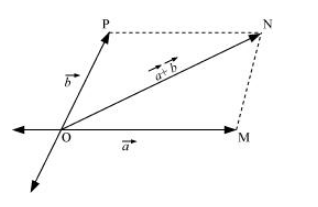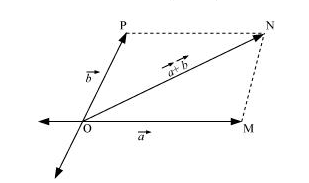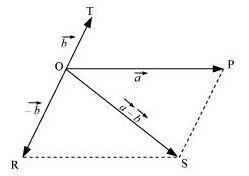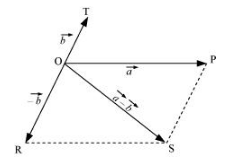Question.
Establish the following vector inequalities geometrically or otherwise:
(a) $|\mathbf{a}+\mathbf{b}| \leq|\mathbf{a}|+|\mathbf{b}|$
(b) $|\mathbf{a}+\mathbf{b}| \geq\|\mathbf{a}|-| \mathbf{b}\|$
(c) $|\mathbf{a}-\mathbf{b}| \leq|\mathbf{a}|+|\mathbf{b}|$
(d) $|\mathbf{a}-\mathbf{b}| \geq|| \mathbf{a}|-| \mathbf{b}||$
When does the equality sign above apply?
Establish the following vector inequalities geometrically or otherwise:
(a) $|\mathbf{a}+\mathbf{b}| \leq|\mathbf{a}|+|\mathbf{b}|$
(b) $|\mathbf{a}+\mathbf{b}| \geq\|\mathbf{a}|-| \mathbf{b}\|$
(c) $|\mathbf{a}-\mathbf{b}| \leq|\mathbf{a}|+|\mathbf{b}|$
(d) $|\mathbf{a}-\mathbf{b}| \geq|| \mathbf{a}|-| \mathbf{b}||$
When does the equality sign above apply?
solution:
(a) Let two vectors $\vec{a}$ and $\vec{b}$ be represented by the adjacent sides of a parallelogram OMNP, as shown in the given figure.

Here, we can write:
$|\overrightarrow{\mathrm{OM}}|=|\vec{a}|$ $\ldots(i)$
$|\overrightarrow{\mathrm{MN}}|=|\overrightarrow{\mathrm{OP}}|=|\vec{b}|$ $\ldots(i i)$
$|\overrightarrow{\mathrm{ON}}|=|\vec{a}+\vec{b}|$ $\ldots(i i i)$
in a triangle, each side is smaller than the sum of the other two sides.
Therefore, in $\Delta O M N$, we have:
$O N<(O M+M N)$
$|\vec{a}+\vec{b}|<|\vec{a}|+|\vec{b}|$ $\ldots(i v)$
If the two vectors $\vec{a}$ and $\vec{b}$ act along a straight line in the same direction, then we can write:
$|\vec{a}+\vec{b}|=|\vec{a}|+|\vec{b}|$ $\ldots(v)$
Combining equations (iv) and $(v)$, we get:
$|\vec{a}+\vec{b}| \leq|\vec{a}|+|\vec{b}|$
(b) Let two vectors $\vec{a}$ and $\vec{b}$ be represented by the adjacent sides of a parallelogram OMNP, as shown in the given figure.

Here, we have:
$|\overrightarrow{\mathrm{OM}}|=|\vec{a}|$ $\ldots(i)$
$|\overrightarrow{\mathrm{MN}}|=|\overrightarrow{\mathrm{OP}}|=|\vec{b}|$ $\ldots(i i)$
$|\overrightarrow{\mathrm{ON}}|=|\vec{a}+\vec{b}|$ $\ldots(i i i)$
In a triangle, each side is smaller than the sum of the other two sides.
Therefore, in $\triangle \mathrm{OMN}$, we have:
$\mathrm{ON}+\mathrm{MN}>\mathrm{OM}$
$\mathrm{ON}+\mathrm{OM}>\mathrm{MN}$
$|\overrightarrow{\mathrm{ON}}|>|\overrightarrow{\mathrm{OM}}-\overrightarrow{\mathrm{OP}}|$ $(\because \mathrm{OP}=\mathrm{MN})$
$|\vec{a}+\vec{b}|>\| \vec{a}|-| \vec{b}|| \ldots$ (iv)
If the two vectors $\vec{a}$ and $\vec{b}$ act along a straight line in the opposite direction, then we can write:
$|\vec{a}+\vec{b}|=|| \vec{a}|-| \vec{b}|| \ldots$ $(v)$
Combining equations (iv) and (v), we get:
$|\vec{a}+\vec{b}| \geq|| \vec{a}|-| \vec{b}||$
(c) Let two vectors $\vec{a}$ and $\vec{b}$ be represented by the adjacent sides of a parallelogram PORS, as shown in the given figure.

Here we have:
$|\overrightarrow{\mathrm{OR}}|=|\overrightarrow{\mathrm{PS}}|=|\vec{b}|$ $\ldots(i)$
$|\overrightarrow{\mathrm{OP}}|=|\vec{a}|$ $\ldots(i i)$
In a triangle, each side is smaller than the sum of the other two sides. Therefore, in $\Delta \mathrm{OPS}$, we have:
$\mathrm{OS}<\mathrm{OP}+\mathrm{PS}$
$|\vec{a}-\vec{b}|<|\vec{a}|+|-\vec{b}|$
$|\vec{a}-\vec{b}|<|\vec{a}|+|\vec{b}|$ $\ldots(i i i)$
If the two vectors act in a straight line but in opposite directions, then we can write:
$|\vec{a}-\vec{b}|=|\vec{a}|+|\vec{b}| \ldots$ (iv)
Combining equations (iii) and (iv), we get:
$|\vec{a}-\vec{b}| \leq|\vec{a}|+|\vec{b}|$
(d) Let two vectors $\vec{a}$ and $\vec{b}$ be represented by the adjacent sides of a parallelogram PORS, as shown in the given figure.

The following relations can be written for the given parallelogram.
$\mathrm{OS}+\mathrm{PS}>\mathrm{OP}$ $\ldots(i)$
$\mathrm{OS}>\mathrm{OP}-\mathrm{PS}$ ... (ii)
$|\vec{a}-\vec{b}|>|\vec{a}|-|\vec{b}|$ $\ldots$ (iii)
The quantity on the LHS is always positive and that on the RHS can be positive or negative. To make both quantities positive, we take modulus on both sides as:
||$\vec{a}-\vec{b}||>|| \vec{a}|-| \vec{b}||$
$|\vec{a}-\vec{b}|>|| \vec{a}|-| \vec{b}||$ $\ldots(i v)$
If the two vectors act in a straight line but in the same directions, then we can write:
$|\vec{a}-\vec{b}|=|| \vec{a}|-| \vec{b}||$ $\ldots(v)$
Combining equations (iv) and (v), we get:
$|\vec{a}-\vec{b}| \geq|| \vec{a}|-| \vec{b}||$
(a) Let two vectors $\vec{a}$ and $\vec{b}$ be represented by the adjacent sides of a parallelogram OMNP, as shown in the given figure.

Here, we can write:
$|\overrightarrow{\mathrm{OM}}|=|\vec{a}|$ $\ldots(i)$
$|\overrightarrow{\mathrm{MN}}|=|\overrightarrow{\mathrm{OP}}|=|\vec{b}|$ $\ldots(i i)$
$|\overrightarrow{\mathrm{ON}}|=|\vec{a}+\vec{b}|$ $\ldots(i i i)$
in a triangle, each side is smaller than the sum of the other two sides.
Therefore, in $\Delta O M N$, we have:
$O N<(O M+M N)$
$|\vec{a}+\vec{b}|<|\vec{a}|+|\vec{b}|$ $\ldots(i v)$
If the two vectors $\vec{a}$ and $\vec{b}$ act along a straight line in the same direction, then we can write:
$|\vec{a}+\vec{b}|=|\vec{a}|+|\vec{b}|$ $\ldots(v)$
Combining equations (iv) and $(v)$, we get:
$|\vec{a}+\vec{b}| \leq|\vec{a}|+|\vec{b}|$
(b) Let two vectors $\vec{a}$ and $\vec{b}$ be represented by the adjacent sides of a parallelogram OMNP, as shown in the given figure.

Here, we have:
$|\overrightarrow{\mathrm{OM}}|=|\vec{a}|$ $\ldots(i)$
$|\overrightarrow{\mathrm{MN}}|=|\overrightarrow{\mathrm{OP}}|=|\vec{b}|$ $\ldots(i i)$
$|\overrightarrow{\mathrm{ON}}|=|\vec{a}+\vec{b}|$ $\ldots(i i i)$
In a triangle, each side is smaller than the sum of the other two sides.
Therefore, in $\triangle \mathrm{OMN}$, we have:
$\mathrm{ON}+\mathrm{MN}>\mathrm{OM}$
$\mathrm{ON}+\mathrm{OM}>\mathrm{MN}$
$|\overrightarrow{\mathrm{ON}}|>|\overrightarrow{\mathrm{OM}}-\overrightarrow{\mathrm{OP}}|$ $(\because \mathrm{OP}=\mathrm{MN})$
$|\vec{a}+\vec{b}|>\| \vec{a}|-| \vec{b}|| \ldots$ (iv)
If the two vectors $\vec{a}$ and $\vec{b}$ act along a straight line in the opposite direction, then we can write:
$|\vec{a}+\vec{b}|=|| \vec{a}|-| \vec{b}|| \ldots$ $(v)$
Combining equations (iv) and (v), we get:
$|\vec{a}+\vec{b}| \geq|| \vec{a}|-| \vec{b}||$
(c) Let two vectors $\vec{a}$ and $\vec{b}$ be represented by the adjacent sides of a parallelogram PORS, as shown in the given figure.

Here we have:
$|\overrightarrow{\mathrm{OR}}|=|\overrightarrow{\mathrm{PS}}|=|\vec{b}|$ $\ldots(i)$
$|\overrightarrow{\mathrm{OP}}|=|\vec{a}|$ $\ldots(i i)$
In a triangle, each side is smaller than the sum of the other two sides. Therefore, in $\Delta \mathrm{OPS}$, we have:
$\mathrm{OS}<\mathrm{OP}+\mathrm{PS}$
$|\vec{a}-\vec{b}|<|\vec{a}|+|-\vec{b}|$
$|\vec{a}-\vec{b}|<|\vec{a}|+|\vec{b}|$ $\ldots(i i i)$
If the two vectors act in a straight line but in opposite directions, then we can write:
$|\vec{a}-\vec{b}|=|\vec{a}|+|\vec{b}| \ldots$ (iv)
Combining equations (iii) and (iv), we get:
$|\vec{a}-\vec{b}| \leq|\vec{a}|+|\vec{b}|$
(d) Let two vectors $\vec{a}$ and $\vec{b}$ be represented by the adjacent sides of a parallelogram PORS, as shown in the given figure.

The following relations can be written for the given parallelogram.
$\mathrm{OS}+\mathrm{PS}>\mathrm{OP}$ $\ldots(i)$
$\mathrm{OS}>\mathrm{OP}-\mathrm{PS}$ ... (ii)
$|\vec{a}-\vec{b}|>|\vec{a}|-|\vec{b}|$ $\ldots$ (iii)
The quantity on the LHS is always positive and that on the RHS can be positive or negative. To make both quantities positive, we take modulus on both sides as:
||$\vec{a}-\vec{b}||>|| \vec{a}|-| \vec{b}||$
$|\vec{a}-\vec{b}|>|| \vec{a}|-| \vec{b}||$ $\ldots(i v)$
If the two vectors act in a straight line but in the same directions, then we can write:
$|\vec{a}-\vec{b}|=|| \vec{a}|-| \vec{b}||$ $\ldots(v)$
Combining equations (iv) and (v), we get:
$|\vec{a}-\vec{b}| \geq|| \vec{a}|-| \vec{b}||$
Click here to get exam-ready with eSaral
For making your preparation journey smoother of JEE, NEET and Class 8 to 10, grab our app now.
